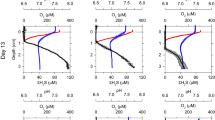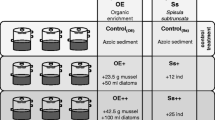Abstract
Laboratory experiments were conducted to investigate the survival rate of Monoporeia affinis in sulphide-rich sediment with oxic overlying water, and the effect of amphipod bioturbation on sulphide and oxygen profiles. As long as the oxygen content in the water is high, the amphipods seem to avoid quite high concentrations (>200 μmol l−1) of sulphide in the sediment by creating microhabitats where sulphide is rapidly oxidised. In cores with amphipods, a decrease of sulphide concentration was found in upper layers, while an increase of sulphide was found in deeper layers. Aggregation of amphipods generated pockets of light-brown sediment, characterised by high oxygen concentrations and no sulphide, and their depth was clearly dependent on amphipod density. This indicates that M. affinis has a potential to recolonise sulphide-rich sediments, devoid of macroscopic life, after the overlying water column has become oxygenated.
Similar content being viewed by others
Author information
Authors and Affiliations
Additional information
Received: 13 April 2000 / Accepted: 8 September 2000
Rights and permissions
About this article
Cite this article
Modig, H., Ólafsson, E. Survival and bioturbation of the amphipod Monoporeia affinis in sulphide-rich sediments. Marine Biology 138, 87–92 (2001). https://doi.org/10.1007/s002270000445
Issue Date:
DOI: https://doi.org/10.1007/s002270000445




